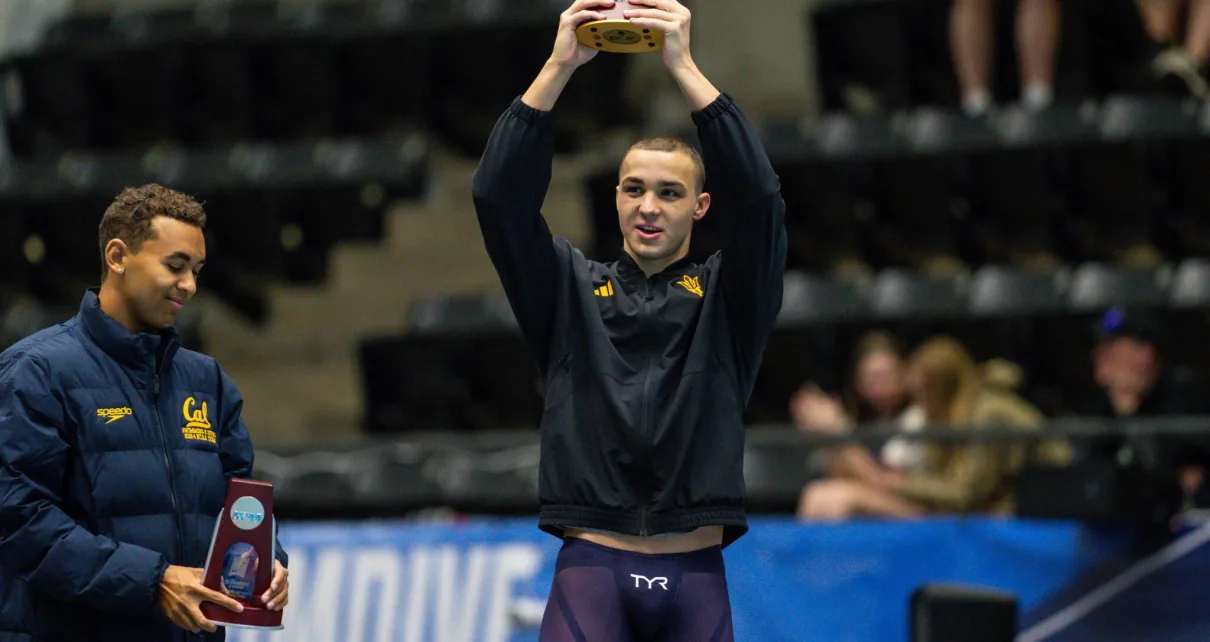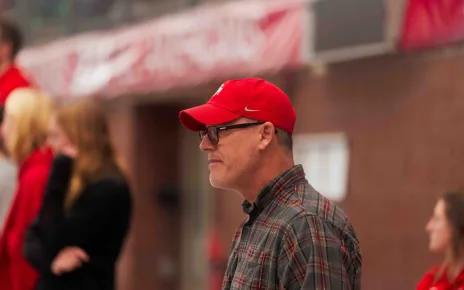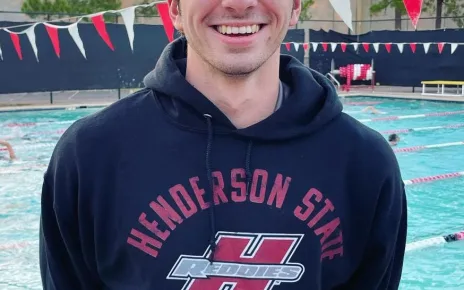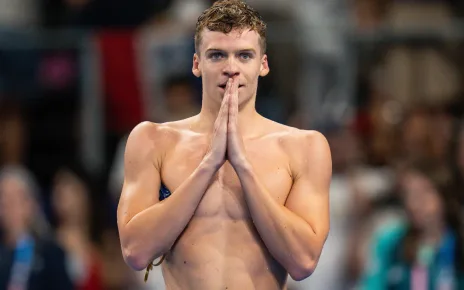UNBELIEVABLE DISCOUNTS AT AMAZON.COM ||
It’s that time of the year again. SwimSwam will be previewing the top 12 men’s and women’s teams (and then some) from the 2024 NCAA Championships. Follow along with the College Swimming Preview Channel. Want to read even more? Check out the latest edition of the SwimSwam magazine.
#1 ARIZONA STATE SUN DEVILS
Key Losses: Leon Marchand (60 NCAA points, 4 NCAA relays), Hubert Kos (48 NCAA points, 2 NCAA relays), Owen McDonald (46 NCAA points), David Schlicht (44 NCAA points), Jack Dolan (29.5 NCAA points, 3 NCAA relays), Zalan Sarkany (25 NCAA points), Alex Colson (7 NCAA points), Julian Hill (5 NCAA points, 1 NCAA relay), Cam Peel (1 NCAA relay)
Key Additions: #15 Michael Hochwalt (WA – distance free/IM), #19 Quin Seider (AZ – sprint free), HM Brady Johnson (IL – sprint free/back/breast), BOTR Tolu Young (Fiji – sprint free), Jonathon Adam (Great Britain – backstroke), Isaac Fleig (WI – distance free), Jacob Pins (IA – free), Lucien Vergnes (France – breast/IM), Finn Kemp (Luxembourg – breast/IM), Oscar Bilbao (Great Britain – breast)
Returning Fifth Years: None
GRADING CRITERIA
Over the years, we’ve gone back and forth on how to project points, ranging from largely subjective rankings to more data-based grading criteria based on ‘projected returning points.’ We like being as objective as possible, but we’re going to stick with the approach we’ve adopted post-Covid. The “stars” will rely heavily on what swimmers actually did last year, but we’ll also give credit to returning swimmers or freshmen who have posted times that would have scored last year.
Since we only profile the top 12 teams in this format, our grades are designed with that range in mind. In the grand scheme of college swimming and compared to all other college programs, top 12 NCAA programs would pretty much all grade well across the board. But in the interest of making these previews informative, our grading scale is tough – designed to show the tiers between the good stroke groups, the great ones, and the 2015 Texas fly group types.
- 5 star (★★★★★) – a rare, elite NCAA group projected to score 25+ points per event
- 4 star (★★★★) – a very, very good NCAA group projected to score 15-24 points per event
- 3 star (★★★) – a good NCAA group projected to score 5-14 points per event
- 2 star (★★) – a solid NCAA group projected to score 1-4 points per event
- 1 star (★) – an NCAA group that is projected to score no points per event, though that doesn’t mean it’s without potential scorers – they’ll just need to leapfrog some swimmers ahead of them to do it
We’ll grade each event discipline: sprint free (which we define to include all the relay-distance freestyle events, so 50, 100 and 200), distance free, IM, breaststroke, backstroke, butterfly and diving. Use these grades as a jumping-off point for discussion, rather than a reason to be angry.
Also, keep in mind that we are publishing many of these previews before teams have posted finalized rosters. We’re making our assessments based on the best information we have available at the time of publication, but we reserve the right to make changes after publication based on any new information that may emerge regarding rosters. If that does happen, we’ll make certain to note the change.
2023-2024 LOOKBACK
The house that Bowman built got the job done last season.
Arizona State was an undeniable force throughout the 2023-24 campaign, crushing the competition en route to a second straight Pac-12 title before powering their way to the first NCAA title in program history.
For the second consecutive season, junior Leon Marchand went three-for-three individually, roaring to new all-time records in the 500 free and 200 breast to go along with a decisive victory in the 400 IM. Over three NCAA Championship appearances, Marchand won eight individual titles and was the runner-up in his other entry (400 IM in 2022).
The Sun Devils also had national titles come from sophomore Zalan Sarkany in the 1650 free, freshman Ilya Kharun in the 200 fly, and they also picked up a pair of relay victories in the 400 free and 400 medley.
Additionally, sophomores Hubert Kos and Owen McDonald went 2-3 in the 200 back and 200 IM, flipping positions in the two events (Kos placing 2nd in the 200 back, McDonald 2nd in the 200 IM), and they also went 4-6 in the 100 back, combining for 94 points between the two of them.
Along with Marchand (60), Kos (48), McDonald (46), Kharun (39) and Sarkany (25), ASU had four more double-digit point scorers at NCAAs: David Schlicht (44), Jack Dolan (29.5), Jonny Kulow (15) and Daniel Matheson (14).
The relays were dynamite, as, on top of the wins in the 400 free and medley, they were also the runner-ups in the 800 free and 200 medley, and 3rd in the 200 free. That gave them 180 points in the relays, and although it was only 10 more than runner-up Cal, those performances played a major role in pushing ASU to the title.
Immediately after the NCAA Championships, the dominoes started to fall. After reaching the top of the mountain, Bob Bowman moved on, accepting the job as the head men’s coach at the University of Texas, and in his wake, several of the team’s top performers from last season left Tempe.
That puts this year’s edition of the Sun Devils in an interesting spot. Repeating as national champions is not even part of the conversation given who they lost, but there is an intriguing combination of returnees and newcomers who will keep the team near the NCAA’s upper echelon.
SPRINT FREESTYLE: ★★★½
Although ASU was a powerhouse in the free relays last year, there wasn’t a massive amount of points scored in the individual sprints.
Jack Dolan (50/100 free) and Julian Hill (200 free) both scored last year and have graduated, but the likes of Jonny Kulow, Ilya Kharun and Patrick Sammon are back after putting up points last year.
Kulow is the team’s top sprinter, having put up times of 18.64 in the 50 and 41.40 in the 100 free last season, ultimately finishing 8th and 13th, respectively, at NCAAs.
Given what he’s done in relays, there’s no question Kulow will be in contention for a top 3-5 finish in both races this year.
Kharun raced the 50 free as his third event to go along with the two fly races, and placed 12th at NCAAs after setting a season-best of 18.82.
Sammon was 19.36/41.77 last year in the sprints and placed 14th in the 200 free at NCAAs in 1:31.99 after a 1:31.87 prelim outing.
That trio gives the Sun Devils three returning scorers in the sprints, and there’s more depth with Tiago Behar and Filip Senc-Samardzic having raced at NCAAs last year and Quin Seider, Tolu Young and Brady Johnson coming in as freshmen.
Behar (19.58/42.56/1:32.86) and Senc-Samardzic (19.73/42.76/1:35.92) are candidates to take over some of the vacant relay spots this season, and Behar could push for points in the 200 free after he was 29th last season (1:32.10 was what it took to make the ‘B’ final).
Seider, the #19 recruit in the incoming class, had a rapid rise during his senior year of high school and comes in with bests of 19.78/43.04/1:34.97. Given the ability Herbie Behm has shown in developing sprinters, there’s no questioning Seider is a potential scorer, although whether or not that comes this season remains to be seen.
Young, who represented Fiji at the Paris Olympics, has been 19.61 in the 50 free and 44.14 in the 100 free, and like Seider, should get a boost from training at ASU.
Johnson is an Honorable Mention recruit and has been 20.24/43.15 in the sprint free events, putting him right there in the mix.
DISTANCE FREESTYLE: ★★
Losing the reigning NCAA champions in the 500 (Marchand) and 1650 free (Sarkany) is certainly a massive blow to ASU’s distance free prospects, though they do bring back one scorer and an array of freshmen with some serious ability.
Daniel Matheson comes back for his senior year after placing 15th in the 500 free and 11th in the mile in 2024, setting personal bests in both races at NCAAs (4:13.00/14:44.24). Carrying that momentum into this season will be paramount for the Sun Devils and their distance free outlook.
The distance group is getting a shot in the arm this year with the additions of Isaac Fleig, Michael Hochwalt and Jacob Pins, who all have similar best times as freshmen.
Fleig, who deferred his enrollment for one year to focus on the Olympic Trials, won the U.S. Junior National title in the 1500 free in 2023 and is coming off setting long course lifetime bests in the 400 free (3:55.90) and 1500 free (15:16.33) at the Speedo Summer Championships in July.
Fleig has been 4:22.9 in the 500 and 15:04.5 in the 1650, and his LC time in the mile converts to 14:58, while Hochwalt is 4:24.5/15:05.7 and Pins is 4:20.8/15:05.7.
Given that Olympian Luke Whitlock is the lone member of this year’s freshman class who is sub-15:00 in the mile, the Fleig/Hochwalt/Pins trio is elite for the Sun Devils, though scoring is not promised right away. (It took 14:47.66 to score last season.)
In the 500 free, ASU had Jake Mason (4:17.88), Jack Wadsworth (4:18.61) and Reece Grady (4:19.76) sub-4:20 last season, and Grady was also 14:56.90 in the 1650, just two seconds shy of NCAA qualification.
So there is plenty of reason for optimism in this distance free group, but Matheson is the only scorer on paper coming in. It’s not out of the question that Fleig can drop big and finish in the top 16 in the 1650, but this is a still a two-star group for now.
BACKSTROKE: ★★
The backstroke group in Tempe was arguably the best in the nation last season with the 1-2 punch of Hubert Kos and Owen McDonald, plus Jack Dolan. In five NCAA swims, that trio scored 66 points, highlighted by Kos and McDonalds’ 2-3 in the 200 back.
With those three departing, there’s a significant hole that’s impossible to fill for the Sun Devils, though they still have some hope to find points.
Their lone returning NCAA backstroker from last season is Jack Wadsworth, who enters his senior year coming off career-best performances in 2023-24.
Wadsworth set a PB of 45.90 in the 100 back at the Wolfpack Invite in November, and added a best of 1:40.64 in the 200 back at Pac-12s. He ended up adding time at NCAAs, but another small drop and he’s right in the thick of the scoring race in the 200 (1:39.92 was 16th).
The newcomers bring plenty of pedigree, led by British recruit Jonathon Adam, who goes 53.60 in the 100 back in long course meters and 51.20 in short course. Backstroke conversions are usually off—46.1 is Adam’s converted SCY time—but we should expect him to be in the 44s which would be scoring position.
He’s also 2:01 LCM/1:55 SCM in the 200, which should put him in the 1:41 range.
There are also domestic recruits Brady Johnson (46.65/1:42.69) and Michael Hochwalt (1:44.51) joining the mix.
Johnson has been on an upward trajectory of late, specifically in the 200 where he took off nearly five seconds during his senior year of high school. It might be a season before he’s in NCAA scoring range, however.
BREASTSTROKE: ★★★½
There’s no area where there’s more reason for optimism for ASU than on breaststroke, though a lot is still unknown.
Leon Marchand, who won three straight NCAA titles in the 200 breast, is gone, as is David Schlicht, who was 5th in the event last season.
The Sun Devils return one breaststroke scorer, Cale Martter, another NCAA qualifier in Andy Dobrzanski, and a trio of international freshmen who could do some damage.
Martter specializes in the 200 breast, having placed 13th at NCAAs in 1:52.42 after setting a PB of 1:52.19 at Pac-12s.
Dobrzanski is fast enough to score in the 100 after clocking a best of 51.52 at the conference championships, but he ended up 24th at NCAAs in 52.16. The scoring cut-off was 51.87. He’s also a threat in the 200, following up a Pac-12 best of 1:52.98 with a 1:54.31 clocking at NCAAs.
But beyond those two, there’s three more men who could end up earning second swims in breast events.
Leading the way is France’s Lucien Vergnes, a former European Junior and European U23 champion who owns elite best times of 1:00.77/2:10.04 in long course meters and 58.63/2:05.61 in short course.
Those times put him in the upper echelon of French breaststroke and given his countryman Marchand’s success at ASU, perhaps Vergnes will be inspired to pick up where he left off. Vergnes’ conversions come in at 52.81/1:53.16, which are probably conservative so we should expect him to be a scorer.
Also joining the Sun Devils this season are Luxembourg’s Finn Kemp and Britain’s Oscar Bilbao.
The two of them own very similar best times, with Kemp having been 1:02.54/2:16.51 in long course and Bilbao at 1:02.46/2:16.93. Bilbao is also 1:00.41/2:11.72 in SCM, giving him a slightly faster conversion in the 200.
Take them with a grain of salt, but Kemp’s times convert to 54.54/1:59.37, while Bilbao’s are 54.42/1:58.66.
We also can’t overlook domestic freshman Brady Johnson, an all-around sprinter who has a best of 53.39 in the 100 breast. Given his backstroke success, and the team’s relative lack of depth there, it’s hard to gauge whether or not the 100 breast will be a part of his program.
BUTTERFLY: ★★★★
With one of the best butterfly swimmers in the world on their squad, ASU will have no trouble piling up fly points this season.
After winning the NCAA title in the 200 fly during his freshman year, Ilya Kharun enters his sophomore campaign fresh off winning a pair of bronze medals in the fly events at the Paris Olympics.
The Canadian will be favored to repeat as the 200 fly winner, while in the 100 fly, Kharun will still have his work cut out for him as the four men who finished ahead of him last year all return. Regardless, with best times of 44.26 and 1:37.93, he makes this a four-star group on his own.
Behind Kharun the butterfly group is a bit thin, especially with Alex Colson graduating after placing 10th in the 200 fly last year.
Filip Senc-Samardzic, another rising Canadian sophomore, owns a PB of 45.18 in the 100 fly and was 28th last year at NCAAs, while Jonny Kulow, primarily a sprint freestyler, went 45.30 during the midseason Wolfpack Invite last year but DFS’d the event at NCAAs.
Incoming freshmen Quin Seider (48.68) and Michael Hochwalt (1:45.21) have some pedigree in the 100 and 200 fly, respectively, but neither figures to focus on the discipline.
The Frenchman Vergnes is 55.97/2:05.28 in long course, and free sprinter Tolu Young could have some potential with a 24.4 PB in the 50 fly LCM and 50.56 in the 100 fly SCY.
IM: ★★★
There’s no replacing the IM points walking out the door from Marchand (20), McDonald (17), Kos (16) or Schlicht (30), but ASU still has a solid group with two returning scorers and some intriguing first-years.
Daniel Matheson (3:39.70) and Cale Martter (3:40.83) placed 11th and 13th respectively last year in the 400 IM at NCAAs, and Martter was 1:42.28 in the 200 at Pac-12s, two-tenths shy of the NCAA scoring cut.
Ilya Kharun also went 1:42.31 in the 200 IM last year, though he tends to focus on the 50 free on Day 2.
The freshman with the best chance to score right from the jump is Michael Hochwalt, who has been 3:42.88 in the 400 IM, less than a second under what it took to score last year (3:41.91). Entering the established IM culture at ASU should help push Hochwalt into scoring range and beyond.
There’s improvement needed in the 200, but Hochwalt (1:47.05), Lucien Vergnes (2:02.15 LCM), Finn Kemp (2:02.94 LCM) and Oscar Bilbao (2:05.07 LCM) have potential.
Even if it’s just Matheson, Martter and Hochwalt in the ‘B’ final of the 400 IM, that’s enough for this to be a three-star group. Given some of the departures in the NCAA, including three of the top four last year in the 400 IM (Marchand, Schlicht, Jack Hoagland), Matheson could push himself into the ‘A’ final as a sub-3:40 swimmer.
DIVING: ★
ASU had no divers competing at NCAAs last year and lose their top scorer from Pac-12s, Zachory Lundgren, to graduation.
They bring back conference scorers Lane Stallworth and Caleb Liban, and add freshman Carson Christiansen to the mix, but don’t have anyone in position to make an impact at the NCAA level.
RELAYS: ★★★★
Note that the grading system doesn’t align perfectly for relays as double points.
Relay grading system:
- 5 star (★★★★★) – 31+ points per relay event
- 4 star (★★★★) – 22-30 relay points per event
- 3 star (★★★) – 12-21 relay points per event
- 2 star (★★) – 5-11 relay points per event
- 1 star (★) – 0-4 relay points per event
Last year’s relays were effectively gutted with Marchand turning pro, Kos heading to Texas, and Dolan, Hill and Cam Peel graduating. Those five swimmers represent 11 of ASU’s 20 NCAA relay legs last year, so more than half of the teams that combined for 180 points will need to be replaced.
Jonny Kulow is the go-to guy for the anchor leg on the 200 and 400 relays, and Ilya Kharun swam on the 200 free and both medleys last season. Patrick Sammon represents the only returning swimmer in the 800 free relay, and he was also in the 400 last year alongside Kulow.
Looking ahead, there are plenty of relay options for Herbie Behm and the coaching staff, but there’s no doubt they’ll be taking a step back after what we saw last year.
| Relay | Losing | Keeping | New Candidates |
| 200 FR-R | Dolan, Peel | Kharun, Kulow | Sammon, Behar, Seider, Young, Johnson |
| 400 FR-R | Marchand, Dolan | Sammon, Kulow | Kharun, Behar, Senc-Samardzic, Seider, Johnson |
| 800 FR-R | Marchand, Kos, Hill | Sammon | Behar, Kharun, Seider, Senc-Samardzic |
| 200 MR | Dolan (BK), Marchand (BR) | Kharun (FLY), Kulow (FR) | Adam (BK), Wadsworth (BK), Dobrzanski (BR), Vergnes (BR) |
| 400 MR | Kos (BK), Marchand (BR) | Kharun (FLY), Kulow (FR) | Adam (BK), Wadsworth (BK), Dobrzanski (BR), Vergnes (BR) |
Tiago Behar and Filip Senc-Samardzic are the top two candidates to join the sprint free relays as returners, while freshmen Quin Seider, Brady Johnson and Tolu Young could also step in and contribute if they have good seasons.
It will be hardest to rebuild the 800 free relay, where Behar (1:32.86) is the next-fastest swimmer on the roster behind Sammon, and then there’s a gap to the likes of Seider (1:34.97), Kharun (1:35.43) and Senc-Samardzic (1:35.92). After swimming on the other four relays last season, it might not be ASU’s top option to put Kharun on the 800 free, but it might make the most sense if they don’t have a few others get into the 1:32 range during the season.
The key for the medley relays will be the backstroke performances of either Jonathon Adam or Jack Wadsworth. Given that Adam is 23.67/51.20 in the 50/100 back in SCM, he should be able to step in and keep ASU near the front of the race at NCAAs.
On the breaststroke leg, replacing Leon Marchand is impossible, but the additions of the internationals, led by Lucien Vergnes, plus the return of the established Andy Dobrzanski, keeps that leg strong for the medleys. And of course, they have one of the best fly/free combos in the nation with Kharun and Kulow.
ASU averaged 36 points per relay last year—more than a relay gets for 2nd place—after two wins, two runner-ups and one 3rd-place showing at NCAAs. They won’t score 180 relay points again this year, as not only have they lost some significant swimmers, but some of their rivals are better than they were in 2023-24. However, this is still a competitive group that should still finish in the top four, five or six of each relay, with the 800 free being the biggest question mark.
Total Stars: 23/40
2024-25 OUTLOOK
Bob Bowman and Leon Marchand led Arizona State to the top of the mountain last season, and then everything changed.
Bowman, Marchand and Hubert Kos have gone to Texas, Owen McDonald and Zalan Sarkany have headed to Indiana, and a number of other top scorers for the Sun Devils last year have graduated.
Ushering in the new era in Tempe under head coach Herbie Behm will be the likes of Ilya Kharun and Jonny Kulow, the only returning swimmers of ASU’s top eight scorers at the 2024 NCAA Championships.
There are some other key returners such as Daniel Matheson, Cale Martter and Patrick Sammon, and the recruiting class brings plenty of promise with ranked domestic swimmers Michael Hochwalt, Quin Seider and Honorable Mention Brady Johnson joined by a talent-filled international group.
The Sun Devils enter a bit of a rebuilding phase after the mass exodus we saw in the offseason, but they’ll still be competitive. Given what Behm has been able to do with the sprint group at ASU and building a culture of excellence, we should expect him to elevate some of the newcomers and keep the relays among the best in the nation.
The team knows what it’s getting from Kharun, Kulow and Matheson, and the relays should deliver. Staying in the top five would be a successful season, and that will hinge on some of the returners taking a step forward and the first-year swimmers seamlessly stepping in and contributing.
MEN’S 2024-25 COLLEGE PREVIEW INDEX
| Team | Sprint Free | Distance Free | Backstroke | Breaststroke | Butterfly | IM | Diving | Relays | Total Stars |
| #1 Arizona State Sun Devils | ★★★½ | ★★ | ★★ | ★★★½ | ★★★★ | ★★★ | ★ | ★★★★ | 23/40 |
| #2 Cal Golden Bears | ★★★★★ | ★★ | ★★★★★ | ★ | ★★★★ | ★★★ | ★★ | ★★★★★ | 27/40 |
| #3 Florida Gators | ★★★★★ | ★★★★★ | ★★★ | ★★★ | ★★★ | ★★★ | ★★ | ★★★★★ | 29/40 |
| #4 Indiana Hoosiers | ★★★½ | ★★★★ | ★★★★ | ★★★★★ | ★★★★ | ★★★½ | ★★★★★ | ★★★★ | 33/40 |
| #5 NC State Wolfpack | ★★★½ | ★★★★½ | ★★★ | ★★½ | ★★★★★ | ★★★ | ★ | ★★★★★ | 27.5/40 |
| #6 Tennessee Volunteers | ★★★★ | ★ | ★ | ★ | ★★ | ★ | ★★★ | ★★★★ | 17/40 |
| #7 Texas Longhorns | ★★★ | ★★★★★ | ★★★★★ | ★ | ★ | ★★★★★ | ★★½ | ★★★★ | 26.5/40 |
| #8 Stanford Cardinal | ★★½ | ★★ | ★★ | ★★★ | ★★★½ | ★★★ | ★★★½ | ★★★★ | 23.5/40 |
| #9 Virginia Tech Hokies | ★★★ | ★ | ★★ | ★★★ | ★★★ | ★★★ | ★ | ★★★½ | 19.5/40 |
| #10 Notre Dame Fighting Irish | – | – | – | – | – | – | – | – | Suspended |
| ★ | ★★★ | ★★★ | ★ | ★★★★ | ★★★★ | ★ | ★★★ | 20/40 | |
| #12 Auburn Tigers | ★½ | ★★★ | ★★½ | ★★ | ★ | ★★½ | ★ | ★★★½ | 17/40 |




